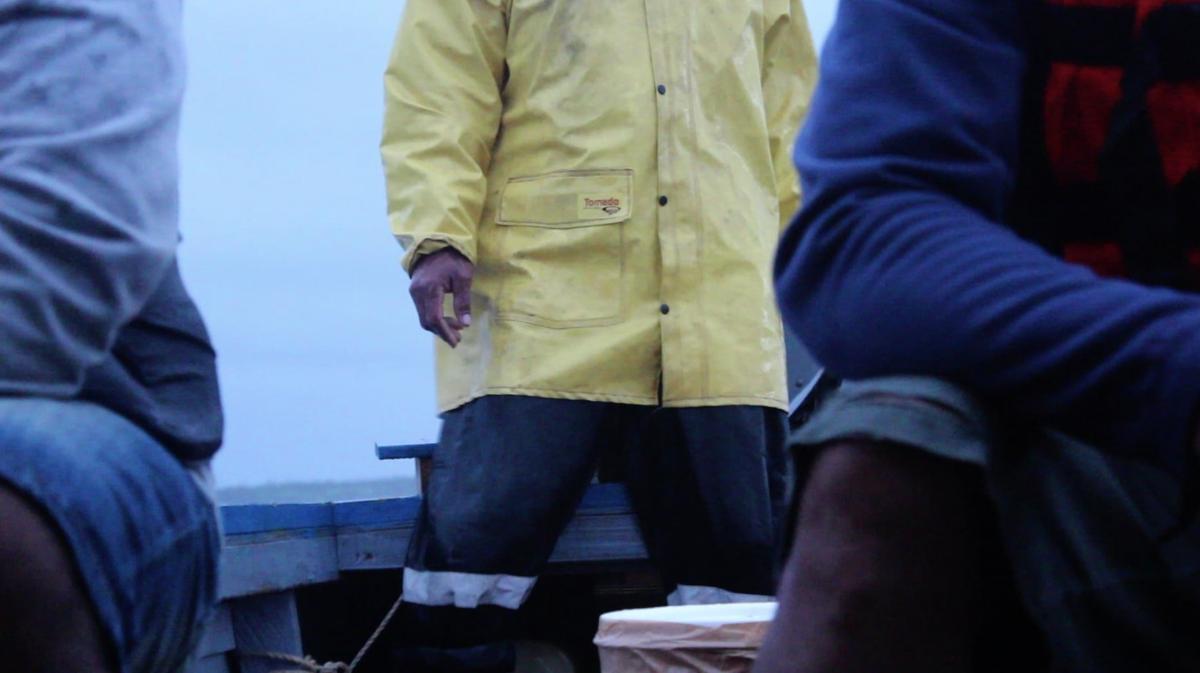Lucy Aukafolau's Invisible Territories was one of 12 works included in Trans-Pacific Transmissions: Video Art Across the Pacific at the Art Gallery of Victoria, British Columbia 4 June-4 September 2016. These notes by Mark Williams were originally commissioned for the accompanying catalogue and look at Aukafolau's work in the context of the proposed Trans-Pacific Partnership Agreement(1) and centuries of Pacific exploration.
Lucy Aukafolau’s Invisible Territories begins with the image of a motorboat prow inching steadily towards a distant island. Shortly after, a second shot reveals lands’ edge as an impenetrable jungle of softly swaying palms. If these sun-drenched images suggest the archetypal Pacific Paradise, the island offers no easy berth. Like many ocean voyagers before her, Aukafolau’s gaze turns to the empty horizon. Her camera fades to black.
Morning O'ua (from Invisible Territories) (2013) Lucy Aukafolau
Polynesian voyagers first arrived in Tonga some 3000 years ago.(2) Much later, in the mid-20th century, Aukafolau’s grandfather was born on the island of O’ua, in the Ha’apai, a group of 51 islands covering approximately 100 kilometres in the centre of Tonga. Aukafolau’s grandfather subsequently moved to the Tongan capital of Nuku'alofa, where he raised two sons. Some time after, all three left their homeland for New Zealand and the promise of economic opportunity.
The small unnamed island that opens Invisible Territories is one of many fringing Ou’a. Even with the assistance of an outboard motor, Aukafolau, her father and uncle are still travelling in much the same way as their ancestors; on board a small craft, with half an eye on the prevailing winds and the clouds above.
In the next scene a motorboat inches forward in pitch black. A hand points, someone moves a bag, and illuminated by torchlight, we see fleeting shots of fluorescent orange lifejackets. On the second screen a shipping freighter appears out of the darkness like an ocean-bound cathedral ablaze with light. On board the dock, one man wears orange safety overalls, a handful of others are dressed in street clothing, while a child watches from the wings. On arrival, passengers leap the gap between the bobbing boat and pontoon, turning to help others with their belongings. One man greets a wharf worker with an outstretched hand, carrying his suitcase in the other.
Dock (from Invisible Territories) (2013) Lucy Aukafolau
This journey is not the end but a stop on the way. Boxes of provisions are loaded back into the hull; washing powder, baking goods, processed food and drinking water the typical staples.
As the dock workers pass the cargo through a chain of hands and down into the boat, it’s hard not to see this collective action as a perfect metaphor for the history of Pacific exploration. For centuries, the islands scattered throughout Tonga operated as connective nodes for explorers and traders. In a 2009 essay entitled Our Sea of Islands Tongan anthropologist Epeli Hau’ofa expanded on this theme;
“The world of our ancestors was a large sea… in which peoples and cultures moved and mingled unhindered by boundaries of the kind erected much later by imperial powers… From one island to another they sailed to trade and to marry, thereby expanding social networks for greater flow of wealth. They travelled to visit relatives in a wide variety of natural and cultural surroundings, to quench their thirst for adventure, and even to fight and dominate… Fiji, Samoa, Tonga, Niue, Rotuma, Tokelau, Tuvalu, Futuna And Uvea formed a large exchange community in which wealth and people with their skills and arts circulated endlessly.”(3)
In the 21st century this concept still resonates. Much of the Tongan community based in New Zealand maintain deep cultural and spiritual connections to their homeland. In material terms, money earned in Auckland can be sent ‘home’ to family. According to Hau’ofa, the culture and value at the heart of this activity is often overlooked outside the islands;
“Economists do not take account of the social centrality of the ancient practice of reciprocity, the core of all Oceanic cultures. They overlook the fact that for everything homelands relatives receive they reciprocate with goods they themselves produce, and they maintain ancestral roots and lands for everyone, homes with warmed hearths for travellers to return to at the end of the day, or to re-strengthen their bonds, their souls and their identities before they move on again.“(4)
The final scene in Invisible Territories is the most visceral. On board another motorboat, Aukafolau’s camera rises and falls with the choppy waves, the horizon line lurches in and out of camera, waves rolling and baying in the wake behind. In the stern the pilot stands in industrial wet weather gear, resolutely guiding the ship forward.
Although it’s queasy watching, this mode of travel has been the norm for centuries of Tongans. While the West often seeks to define itself – and others - through the divide of land and sea, the people of Tonga have long accepted the ocean not so much a border, but as an extension of psycho-geographical space.
Could Tonga be the largest country in the world? How would such a concept be supported in the context of globalization? What impact will emergent international trade treaties have on traditional notions of Tongan exchange, reciprocity and value?
